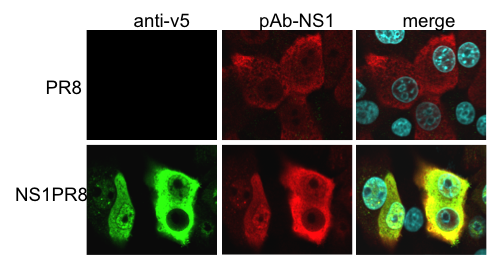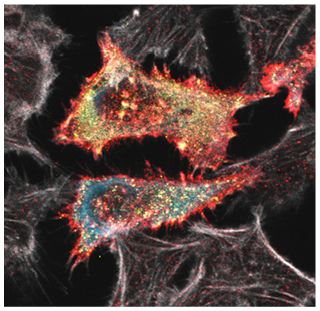Teresa Aydillo-Gomez, Ph.D.
The NS1 protein of influenza viruses acts as a virulence factor by inhibiting host immune responses through suppression of the type I IFN system. My research is focused on the viral mechanisms of immune modulation and evasion of influenza viruses, particularly in newly emergent viruses like the influenza A viruses discovered in bats. Using standard reverse genetics techniques, we have generated recombinant influenza viruses in order to address the specific role of the NS1 protein in bat influenza viruses.

Intracellular localization of the NS1 protein from influenza viruses during infection in human A549 cells (MOI 2) with the mice adapted influenza virus PR8 and a recombinant virus by indirect immunofluorescence.
Raquel Muñoz-Moreno, Ph.D.
My work is focused on the adaptation of the influenza A virus NS1 protein to the host. A collection of NS1 proteins was selected based on different structural and functional sequence feature variant types (SFVT), thus creating a library that contained a representative variants of the NS1 proteins found in nature. A library of 120 recombinant viruses was constructed by using a split NS segment that contained a neutral barcode of 22 nt. This barcode can be used as a tag to label each of the recombinant viruses of the library so they can be quantified using the Illumina deep-sequencing platform. This approach will help further uncover new information regarding the role of NS1 in the different stages of the influenza A viral cycle.

Diagram of the modified NS segment with the barcode tag downstream of NS1, which will be used in this project.
Juan Ayllon, Ph.D.
My work mainly focuses on the NS1 protein of the influenza virus, a virulence factor with an outstanding array of functions. I have studied the structural basis of NS1 multi-functionality, and have developed a bimolecular fluorescence complementation assay to track the multiple protein-protein interactions in which NS1 is involved. While my research touches on the well characterized NS1-mediated inhibition of interferon by repression of the RIG-I signaling axis, I am also exploring the viral activation of the cellular PI3K network, a critical and complex regulatory checkpoint. I have also worked on the characterization of the NS1 proteins of novel and emerging influenza viruses (the avian H7N9 virus causing outbreaks in China and the recently discovered H17N10 and H18N11 bat influenza virus strains), in which I have shown how naturally occurring mutations of specific NS1 residues can lead to gain-of-function phenotypes, which enhancing virulence.


